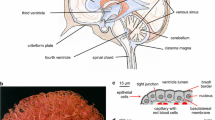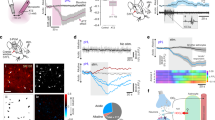Abstract
The extracellular pH,\(P_{CO_2 } \), and [Cl−] at the surface of the brain cortex, expiratory\(P_{CO_2 } \) and arterial blood pressure were continuously recorded in anaesthetized and artificially ventilated cats. The observations from such a preparation were:
-
1.
In response to a nearly step increase in end-tidal\(P_{CO_2 } \), the brain ECF pH,\(P_{CO_2 } \), [Cl−] and calculated [HCO −3 ] changed in the form of a nearly mono-exponential time function after a delay of 5–7 s.
-
2.
The time constants of the changes in the extracellular pH,\(P_{CO_2 } \), [Cl−] and [HCO −3 ] were in the range of 30–40 s.
-
3.
The extracellular [HCO −3 ] increased markedly at an initial rate of 4.22 mmol·l−1·min−1 after 36 s.
-
4.
This increase occurred almost simultaneously with a decrease in the extracellular [Cl−]. An [HCO −3 ]−[Cl−] exchange ratio was determined which very closely approached one.
It is concluded that the brain extracellular bicarbonate concentration in respiratory acidosis increases because the H+ formed from the hydrated CO2 reacts with the intracellular buffers of brain cells, mainly glial cells, and HCO −3 inside the cell is formed and exchanged for Cl− outside the cell similar to the HCO −3 /Cl− exchange which occurs between red cells and blood plasma during CO2 loading. The described time constants of the anion exchange represent thewash in orwash out time of CO2 in a tissue containing intracellular buffer.
Similar content being viewed by others
References
Ahmad HR, Berndt J, Loeschcke HH (1976) Bicarbonate exchange between blood, brain extracellular fluid and brain cells at maintained\(P_{CO_2 } \). In: Loeschcke HH (ed) Acid homeostasis of the brain extracellular fluid and the respiratory control system. Thieme, Stuttgart, pp 19–27
Ahmad HR, Loeschcke HH, Woidtke HH (1978) In vivo transient and steady state HCO −3 −\(P_{CO_2 } \) relationship of the brain extracellular fluid. Fed Proc 37:903
Ahmad HR, Loeschcke HH, Woidtke HH (1978) Three compartment model for the bicarbonate exchange of the brain extracellular fluid with blood and cells. In: Fitzgerald RS, Gautier H, Lahiri S (eds) Regulation of respiration during sleep and anaesthesia. Plenum Press, New York, pp 195–209
Ahmad HR, Loeschcke HH (1982) Fast bicarbonate-chloride exchange between plasma and brain extracellular fluid at maintained\(P_{CO_2 } \). Pflügers Arch 395:300–305
Borison HL, McCarthy LE (1973) CO2 ventilatory response time obtained by inhalation step forcing in decerebrated cats. J Appl Physiol 1:1–7
Brodie DA, Woodbury DM (1958) Acid-base changes in brain and blood of rats exposed to high concentrations of carbon dioxide. Am J Physiol 192:91–94
Davies DG (1976) Cerebrospinal fluid sampling technique and Astrup pH and\(P_{CO_2 } \) values. J Appl Physiol 40:123–125
Dermietzel R (1976) Central chemosensitivity, morphological studies. In: Loeschcke HH (ed) Acid-base homeostasis of the brain extracellular fluid and the respiratory control system. Thieme, Stuttgart, pp 52–65
Giacobini E (1976) A cytochemical study of the localization of carbonic anhydrase in the nervous system. J Neurochem 9:169–177
Granholm L, Ponten U (1969) The in vivo CO2 buffer curve of the intracellular space of cat cerebral cortex. Acta Neurol Scand 45:493–501
Heijst ANP van, Visser BF, Maas AHJ (1961) A micromethod for the determination of pH and\(P_{CO_2 } \) in human cerebrospinal fluid. Clin Chim Acta 6:586–590
Kazemi H, Mithoefer JC (1963) CO2 dissociation curve of dog brain. Am J Physiol 205:598–600
Kazemi H, Shore NS, Shih UE, Shannon DC (1973) Brain organic buffers in respiratory acidosis and alcalosis. J Appl Physiol 34:478–481
Koch A, Ranck JB Jr, Newman BL (1962) Ionic content of neuroglia. Exp Neurol 6:186–200
Lambertsen CJ (1960) Carbon dioxide and respiration in acid-base homeostasis. Anesthesiology 21:642–651
Leusen I, Weyne J (1976) Metabolic processes in the brain during respiratory and non-respiratory alkalosis and acidosis. In: Loeschcke HH (ed) Acid-base homeostasis of the brain extracellular fluid and the respiratory control system. Thieme, Stuttgart, pp 27–44
Loeschcke HH (1955) Über Bestandspotentiale im Gebiet der Medulla oblongata. Pflügers Arch Ges Physiol 262:517–531
Loeschcke HH (1973) Control of the acid-base status of brain extracellular fluid by the ventilation. Clin Physiol (Tokyo) 3:156–169
Loeschcke HH (1974) The apparent specificity of CO2 as a respiratory stimulus. Bull Physiopathol Resp 10:858–876
Loeschcke HH, Ahmad HR (1980) Transients and steady state of chloride-bicarbonate relationships of brain extracellular fluid. In: Bauer C, Gros G, Bartels H (eds) Biophysics and physiology of carbon dioxide. Springer, Berlin Heidelberg New York, pp 439–448
Luttmann A, Mückenhoff K, Loeschcke HH (1978) Fast measurement of the CO2 partial pressure in gases and fluids. Pflügers Arch 375:279–288
Maren TH (1967) Carbonic anhydrase: chemistry, physiology and inhibition. Physiol Rev 47:595–781
Marmont G (1949) Studies on the axon membrane. J Cell Comp Physiol 34:351–382
Middendorf T, Loeschcke HH (1974) Approximative Berechnung der Pufferbase, einer Titrationsgeraden für Proteine und der CO2-Dissoziationskurve des Gehirngewebes. Pflügers Arch 349:1–8
Nattie EE, Romer L (1978) The role of chloride and other anions in cerebrospinal fluid bicarbonate regulation. In: Fitzgerald RS, Gautier H, Lahiri S (eds) The regulation of respiration during sleep and anaesthesia. Plenum Press, New York, pp 211–128
Nattie EE, Romer L (1978) CSF HCO −3 regulation in isoosmotic conditions: The role of brain\(P_{CO_2 } \) and plasma HCO −3 . Resp Physiol 33:177–198
Nichols G Jr (1958) Serial changes in tissue carbon dioxide content during acute respiratory acidosis. J Clin Invest 37:1111–1122
Pannier JC, Weyne J, Leusen I (1971) The CSF/blood potential and the regulation of the bicarbonate concentration of CSF during acidosis in the cat. Life Sci 10:287–300
Ponten U (1966) Acid-base changes in rat brain tissue during acute respiratory acidosis and basiosis. Acta Physiol Scand 68:152–163
Reed DJ, Woodbury DM, Holtzer RL (1964) Brain edema, electrolytes and extracellular space: Effect of triethyl tin on brain and skeletal muscle. Arch Neurol 10:604–616
Roos A (1965) Intracellular pH and intracellular buffering power of the cat brain. Am J Physiol 209:1233
Siesjö BK (1962) The bicarbonate/carbonic acid buffer system of he cerebral cortex of cats, as studied in tissue homogenates. I. The amount of carbon dioxide bound at different carbon dioxide tensions. With a critique of the application of chloride space measurements to the study of the acid-base metabolism of the brain. Acta Neurol Scand 38: 98–120
Siejö BK, Ponten U (1966) The buffering capacity of brain tissue and of equivalent systems. NY Acad Sci 133:180–194
Swanson AG (1966) The role of bicarbonate in brain buffering. Am Neurol Ass 91:344–345
Swanson AG, Rosengren H (1962) Cerebrospinal fluid buffering during acute experimental respiratory acidosis. J Appl Physiol 17:812–814
Weyne J, Demeester G, Leusen I (1968) Bicarbonate and chloride shifts in rat brain during acute and prolonged respiratory acid-base changes. Arch Int Physiol 75:415–433
Weith JO, Brahm J, Funder J (1980) Transport and interactions of anions and protons in the red blood cell membrane. Ann NY Acad Sci 341:394–418
Author information
Authors and Affiliations
Additional information
Supported by the ‘Deutsche Forschungsgemeinschaft, SFB 114 Bionach’
Rights and permissions
About this article
Cite this article
Ahmad, H.R., Loeschcke, H.H. Fast bicarbonate-chloride exchange between brain cells and brain extracellular fluid in respiratory acidosis. Pflugers Arch. 395, 293–299 (1982). https://doi.org/10.1007/BF00580792
Received:
Accepted:
Issue Date:
DOI: https://doi.org/10.1007/BF00580792




